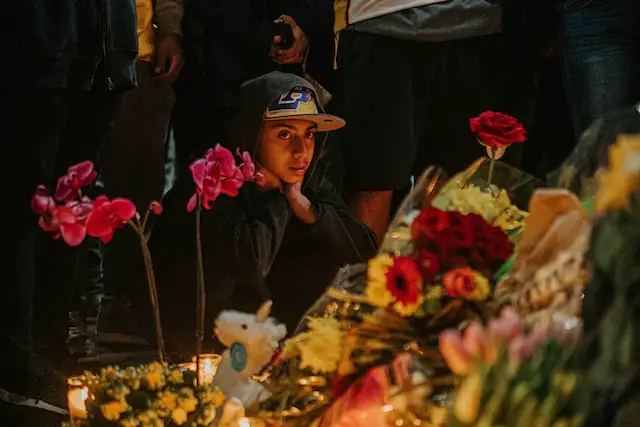Mourning is the outward expression of grief, while grief is the internal emotional response to loss, often involving sadness and sorrow.
TL;DR Mourning Vs. Grieving
Mourning refers to the outward expressions of sorrow and grief that are typically displayed after a loss or death. It involves rituals, customs, and cultural practices that help individuals process their emotions.
Grieving is an internal response to loss that encompasses a wide range of emotions such as sadness, anger, confusion, and even guilt. It is a deeply personal experience characterized by the individual’s psychological journey through the stages of grief.
Understanding the meaning of mourning

Mourning is the outward expression of grief. It is how we process and cope with the loss of someone or something significant in our lives.
Mourning often involves rituals, customs, and traditions that vary across different cultures and societies. These practices serve as a way to honor and remember the deceased, providing a sense of closure for those left behind.
While mourning may involve public displays of sadness such as wearing black clothing or attending memorial services, it also encompasses private moments of reflection and introspection. It is in these quiet moments that we grapple with our emotions, allowing ourselves to feel the pain and sorrow associated with loss.
The process of mourning can be cathartic as it allows us to release pent-up emotions, enabling healing to take place gradually over time. It provides an outlet for our grief while helping us navigate the challenging terrain of bereavement.
Mourning is not limited solely to death; it can also apply to other types of losses such as the end of a relationship or even losing a job. In essence, it is about acknowledging what has been lost and finding ways to adapt to life without it.
Understanding mourning means recognizing that each person’s journey through grief will be unique. There are no right or wrong ways to mourn – only what feels authentic and true for you.
Understanding the meaning of grieving

Grieving is a deeply personal and individual experience that occurs when we have suffered a significant loss. It is an emotional response to the pain and sadness caused by losing someone or something important to us. While mourning may seem similar, grieving encompasses a broader range of emotions and processes.
When we grieve, we go through various stages and emotions such as denial, anger, bargaining, depression, and acceptance. These stages don’t necessarily occur in a linear progression; they can come in waves or be experienced simultaneously. Grief can also manifest physically with symptoms like fatigue, changes in appetite or sleep patterns.
It’s important to note that grief isn’t limited to just losing a loved one; it can apply to any substantial loss in our lives – the end of a relationship, job loss, or even the passing of a beloved pet.
Grieving allows us to process our feelings of loss and adjust to life without what has been taken from us. It provides an opportunity for healing and growth as we learn how to navigate life’s challenges without the presence of what once was.
In essence, grieving is an essential part of the human experience that helps us cope with profound losses. It allows us to honor our emotions while gradually finding ways to move forward amidst heartache.
Mourning Vs. Grieving – Key differences
| Aspect | Mourning | Grieving |
|---|---|---|
| Definition | Outward expressions and rituals in response to a loss, often influenced by culture and traditions | Internal emotional response to loss, involving feelings of sadness, sorrow, and adjustment |
| Timing | Typically occurs in the immediate aftermath of a loss, often as part of funeral or memorial ceremonies | A process that can extend over a longer period and may last for months or years |
| Public vs. Private | Often a public or communal activity, involving family, friends, and the broader community | A highly personal and individual experience, although it may be shared with close loved ones |
| Cultural Influence | Affected by cultural customs and practices, with specific mourning traditions in different societies | Less influenced by culture, as the experience of grief is a universal human response |
| Expressions | Can involve specific actions like wearing black, holding memorial services, or following mourning customs | Involves a wide range of emotions, thoughts, and behaviors that vary from person to person |
| Coping Mechanism | Provides a structured outlet for grief, allowing individuals to come to terms with the loss | Represents the emotional and psychological process of adapting to life without the lost person or thing |
| Connection to Loss | An external manifestation of grief that helps individuals acknowledge and pay tribute to the deceased | The internal experience of processing and coming to terms with the emotional impact of the loss |
Image Credits
Featured Image By – Tom Pumford on Unsplash
Image 1 By – Freddy Kearney on Unsplash
Image 2 By – Marcus Ganahl on Unsplash






